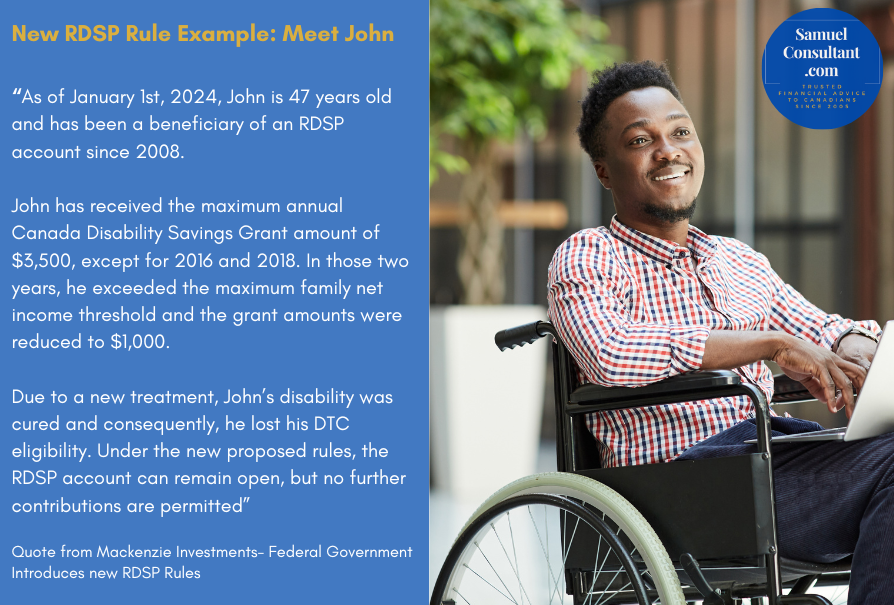When it comes to RDSP, there’s a lot to think about, right? I recently had some families come to me with a pretty important question: what happens to their RDSP if they no longer qualify for the Disability Tax Credit (DTC)?
There could be many different reasons why the Disability Tax Credit is no longer approved – for example, the beneficiary’s disability condition is significantly improved, a doctor refuses to fill out the T2201 form, the CRA approval criteria changes.
Anyhow, since the RDSP already has many complex rules, losing the DTC eligibility definitely throws a bit of a curveball into the mix. So, let me go over what has happened, and what the current rules are regarding this.
A few years back, if someone lost their DTC, they were basically in a bit of a bind. They’d either have to close their RDSP or go through the hassle of obtaining a medical certification to apply for an extension. Not the easiest thing to do.
But, here’s the good news – things have changed for the better now. If someone loses their DTC eligibility, they don’t have to shut down their RDSP anymore. The catch, though, is that while they’re not eligible for the DTC, they can’t put any new contributions into their RDSP, nor can they get grants or bonds.
It’s a bit of a pause button on the account, but at least it doesn’t mean having to close it entirely, which is a big relief for a lot of folks. It keeps the RDSP as part of their financial planning without the pressure of having to make a quick decision if their DTC status changes.
a transfer may be permitted from a deceased parent’s or grandparent’s RRSP, RRIF or RPP on a tax-deferred basis to the RDSP until the end of the fifth calendar year following the loss of the DTC
Quote from Mackenzie Investments- Federal Government Introduces New RDSP Rules
So what are the withdrawal options when the RDSP beneficiary loses the DTC eligibility?
Option#1: The beneficiary who loses DTC eligibility could wait until age 60 to start making withdrawals. This method could prevent any claw back of the Canada Disability Savings Grants (CDSG) / Canada Disability Savings Bonds (CDSB). And it’s the most straightforward way.
Option#2: If the beneficiary who loses DTC eligibility makes a withdrawal under the age of 50, then they are required to repay the lesser of:
- All the grants and bonds they received in the 10 years leading up to the date in which they were DTC-ineligible (10-year repayment rule)
- Or 3 times the amount withdrawn (in grants and bonds)
Option#3: If a beneficiary who loses DTC eligibility makes a withdrawal between the ages of 50 and 60 makes a withdrawal, the 10-year repayment rule still applies except it would reduce every year as they age towards 60.
For example, at age 53, it would become 7-years of repayment and at age 60 it would be 0.

Image for illustration purposes only, not an actual depiction of John
Closing Insights:
As you can see, when a beneficiary loses their DTC eligibility, the results can vary depending on their age at the time of withdrawal. For those interested in a more detailed review of the withdrawal rules, here are two highly informative whitepapers from Mackenzie:
But in short, if your goal is to avoid any clawback of government grants and bonds, you should wait until age 60 to start withdrawals. By then, you can withdraw the amount based on the LDAP formula.
However, if possible, you should consider re-applying for the Disability Tax Credit. After all, you may re-qualify to receive the matching grants and bonds. (Note: The Canada Disability Savings Grant (CDSG) and the Canada Disability Savings Bond (CDSB) are payable until the end of the year in which the beneficiary turns 49. There are maximum limits for CDSG and CDSB per beneficiary).
Additionally, the DTC can be used to reduce income tax. If you need more guidance in applying for the Disability Tax Credit, here’s a guide with helpful explanation videos.
So I hope you find this post helpful. If so, please share it with other families who could benefit from it. Also, if you have any RDSP-related questions, you are welcome to send me a private email at Samuel@SamueConsultant.com.
Stay informed with our e-newsletter, where I share regular financial updates tailored specifically for Canadians with disabilities. Subscribe to stay ahead with financial insights that matter to you.
Sources:
- Canada.ca – Registered Disability Savings Plan
Disclaimer:
The comments contained herein are a general discussion of certain issues intended as general information only and should not be relied upon as investment, financial, legal, accounting or tax advice. Please obtain independent professional advice, in the context of your particular circumstances. This newsletter was written, designed and produced by Samuel Li for the benefit of Samuel who is Advisors at : SamuelConsultant.com is a registered trade name with Investia Financial Services Inc., and does not necessarily reflect the opinion of Investia Financial Services Inc. The information contained in this article comes from sources we believe reliable, but we cannot guarantee its accuracy or reliability. The opinions expressed are based on an analysis and interpretation dating from the date of publication and are subject to change without notice. Furthermore, they do not constitute an offer or solicitation to buy or sell any securities.
Mutual Funds, approved exempt market products and/or exchange traded funds are offered through Investia Financial Services Inc.
Commissions, trailing commissions, management fees and expenses all may be associated with mutual fund investments. Please read the simplified prospectus before investing. Mutual funds are not guaranteed and are not covered by the Canada Deposit Insurance Corporation or by any other government deposit insurer. There can be no assurances that the fund will be able to maintain its net asset value per security at a constant amount or that the full amount of your investment in the fund will be returned to you. Fund values change frequently and past performance may not be repeated. Investia is not liable and/or responsible for any non mutual fund related business and/or services.

